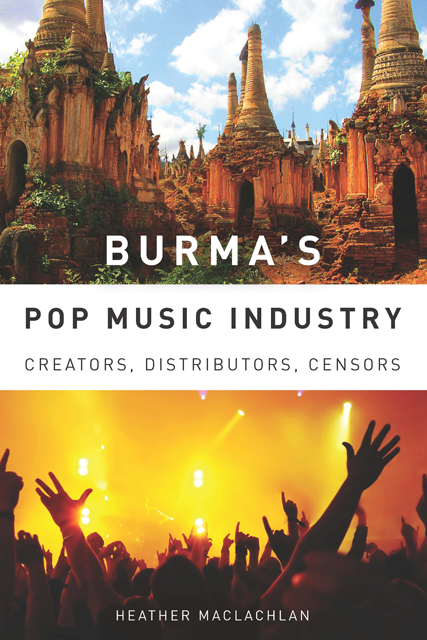Book contents
- Frontmatter
- Dedication
- Contents
- List of Illustrations
- Acknowledgments
- Introduction
- 1 The Creators of Burmese Pop Music
- 2 The Sound of Burmese Pop Songs
- 3 Learning Music in Burma Today
- 4 Six Facets of the Burmese Pop Music Industry
- 5 Musicians and the Censors: The Negotiation of Power
- Conclusion: The Significance of the Burmese Perspective
- Notes
- Bibliography
- Index
- Frontmatter
- Dedication
- Contents
- List of Illustrations
- Acknowledgments
- Introduction
- 1 The Creators of Burmese Pop Music
- 2 The Sound of Burmese Pop Songs
- 3 Learning Music in Burma Today
- 4 Six Facets of the Burmese Pop Music Industry
- 5 Musicians and the Censors: The Negotiation of Power
- Conclusion: The Significance of the Burmese Perspective
- Notes
- Bibliography
- Index
Summary
In 1755 King Alaungpaya, the founder of the last great Burmese monarchical dynasty, arrived at the small fishing village of Dagon. At the end of a long campaign to conquer and unify much of what we now know as Burma, he decided to found his new capital. He renamed the location Yan-gon, meaning “the end of strife.” Standing in modern-day Yangon (also known as Rangoon), it is easy to imagine what Alaungpaya must have seen. Undoubtedly he raised his eyes to the glorious sight of the Shwedagon Pagoda, where devout Buddhists have venerated a shrine containing eight hairs from the head of Gautama Buddha for more than a millennium. He must have seen small family homes made of bamboo, and women carrying their produce to market in baskets balanced on their heads. He would have given alms to saffron-robed monks who wandered the streets at dawn, begging bowls in hand.
It is easy to picture the scene as it looked 250 years ago because, in many ways, the city still resembles the village where Alaungpaya rested. Nowadays, of course, the bamboo huts are interspersed with concrete and steel; there seems to be a new construction project on every major thoroughfare. Cars race past the open-air markets, and monks wear eyeglasses and ride public buses. But glimpses of the older Yangon are everywhere in the contemporary city.
We can still see some of what Alaungpaya saw, and we can still hear some of what he heard. The musical tradition that flourished in the courts of kings like Alaungpaya, known as the Maha Gita, continues to develop today as a vibrant and important part of Burmese life in the twenty-first century. The Maha Gita is a body of song texts written down some centuries ago; the melodies that accompany these texts have been passed down orally. The songs are accompanied by a variety of distinctively Burmese musical instruments, such as the saung gauk (harp) and the pattala (xylophone). The king’s mighty instrumental ensemble, known as the hsaing waing, includes a set of pitched drums called the pat waing; tuned gongs; and the hnay, an aerophone with a particularly piercing sound. Now, as then, singers and instrumentalists trained in the Maha Gita perform for Buddhist rituals and at weddings, and play an important part in public festivals.
- Type
- Chapter
- Information
- Burma's Pop Music IndustryCreators, Distributors, Censors, pp. 1 - 13Publisher: Boydell & BrewerPrint publication year: 2011

